Decorative onions - an attractive bulbous plant, which is distinguished by a variety of species, it will be a decent decoration of any garden or flower beds. Its spherical inflorescences can be admired from the end of the spring to September, and even when they are swinging, openwork balls look very impressive, towering over the rest of the plants.
The decorative onion (allium) refers to the onion family, therefore it has a somewhat specific smell due to the presence of essential oils in the plant. We became known about the decorative Luke since the times of ancient Rome, from where his name happened ("Allium" - garlic). It was used not only for the preparation of a variety of dishes, but also as decoration and decorating yard and flower beds.
To date, there are about 600 species of this plant. All varieties of decorative onions are so diverse that they differ not only by the form of inflorescences and color, but also leaves, and the height of the stem. Its leaves can be linear, swordless, removal, and the height of the tubular stem can reach the height of up to 1 meter and higher. But the delicate sacramental inflorescences of an umbrella type, consisting of small flowers, which, depending on the species, can be given different flowers, which can be different and color depending on the species. The flowering time is most of the species of decorative onions May-June, but there are varieties that begin flowering in the fall.
Types of decorative bows
- Onions Sicilian (nectaroscududwoman), the second name "Honey Garlic". This is a rather high plant, its height reaches up to 1.2 m. Inflorescences - a large bent umbrella, with flowers of different lengths in pale pink, cream colors. Unusual and attractive inflorescences in dried form are used to compile decorative bouquets and compositions.
- Onions Karatavsky - a low plant, its length reaches 30 cm, with a disproportionately large and unusually beautiful spherical inflorescence in lilac or white tones. The diameter of the ball is up to 10 cm. Of particular appeal to the leaves of oval shape with purple streaks. Flowering time - June.
- Onions Blue - one of the most beautiful and luxurious types of allyiums, it is also called "Royal". A gentle - blue ball (diameter up to 5 cm) attaches to a special charm, the height of the plant is up to 90 cm. The flowering period is July, and the leaves are ready for use already in April.
- The onion is giant - the highest view of allyiums, its length reaches the average growth of a person, up to 170 cm. Inflorescences - large, in diameter - 15 cm. Due to the high growth, the plant needs a gap, since the high gusts of the wind can break it. Giant leek flowers in the early summer.
- Onions of Christoph or the "Star of Persia", his bright lilac shades Openwork spherical inflorescences resemble fireworks, and flowers are like stars. In the diameter, the balls reach up to 30 cm and bloom up to 1.5 months. Linear leaves, narrow, pointed at the end.
- Onions moths or Golden Garlic - a low plant with a height of up to 35cm with yellow inflorescences in the form of a flat umbrella. Flowers in June.
- Round onions - a decorative bow, which has the inflorescence of an unusual shape - slightly elongated oval. This variety belongs to late creation representatives. In the diameter of the balls up to 2 cm. The decorative onion flower of the round-headed is found in a variety of colors and amazes variety: from pale pink to dark burgundy shades. Flowering time - from June to the beginning of autumn.
Decorative bow. Landing
Preparation for landing
If you want in your garden all summer bloom and pleased the eye decorative onions, first of all choose to land a well-lit place on the site. To provide a plant, the development of large flowers and saturated color of the leaves, the soil must be loose and preferably well drained. It is recommended to add some sand and mineral fertilizer with potassium to the ground. For landings, choose only healthy bulbs, without spots, mold and shoots.
Landing, as a rule, is made in the fall, from mid-September to October, to give the bulbs to root up to the first frosts. The decorative onion needs a sufficient number of potassium, so in front of landing in the soil, wood ash adds, and in the summer, soil feels with liquid mineral fertilizers.
Landing
- Make small narrow wells. The depth of the wells should be equal to the double height of the bulbs.
- The distance between the wells should be up to 30 cm.
- Moisten the hole and put the bulb.
- Put the earth by hiding the soil. From above the bulb, it is desirable to spray with a reworked manure and inspire peat to prevent the fruit of the soil.
Reproduction of decorative Luke
Decorative onions breeds seeds or division of rhizomes of maternal bulbs (subsidiaries of bulbs).
The seeds of the decorative onion are sipped in spring or autumn. But it is better to sow seeds under the winter so that they go through natural preparations for soil and temperature differences. It is worth noting that after sowing seeds, the lowest grades of the bow will bloom only on the third year, and high on the fifth six, while the bulb does not reach the desired size. For sowing, choose seeds with developed seed boxes.
Mainly for the reproduction of Allyum uses the division of the maternal bulbs. Decorative onion grows in one place under 5 years old, then it should be digging and seeding. You will see that in the bulbs there were subsidiaries that should be divided. The reproduction in this way is rejuvenated by the plant and the flower decorative will retain.
Decorative bow. Care
Decorative onion unpretentious in care. It should be remembered that his homeland is warm countries with a dry climate, so in a special watering it does not need. The soil should be moderately moistened, it should be watering as needed. In the arid soil, its growth can suspend, and when watering is rapidly resumed.
Facing the plant is carried out in the spring, as soon as the first leaves will grow. Use comprehensive mineral fertilizer. Autumn - time to fertilize potassium and phosphorus.
It is recommended to dig bulbs annually to protect them from rot. The plant must fully fade, and the seeds are mature. Keep the bulWhi in a cool place, setting in boxes or cardboard boxes. Reducing Lukovits Demition is held every 3-4 years. The peculiarity of the care of the decorative bow - the plant cannot be clogged by fading leaves, so it is recommended to plant it so that other plants can disguise their unattractive lower part. Decorative onions are subject to pest - onion flies. Fungicide helps to fight the pest.
Application in the garden
Due to the extraordinary diversity of decorative onion varieties, its flowering over the entire summer period, allium is successfully used to create luxurious allaya or onion gardens compositions. The decorative onion plan is superbly with large groups (50 bulbs per square meter), creating dense flowering carpets. Especially such landing looks spectacularly against the background of shrubs and trees.
Low varieties are ideal for rocky gardens and slides, flower, and high varieties are great for a beautiful back plan. Decorative onions are successfully used to create borders, which can be multi-tiered, using varieties of various colors. Allyium is combined with any plants, compositions in the neighborhood with iris, bells, geranium, dolphiniums, as well as with roses look especially nicely. Dry inflorescences of the decorative bow do not lose their attractiveness and is successfully used to compile decorative compositions and bouquets.

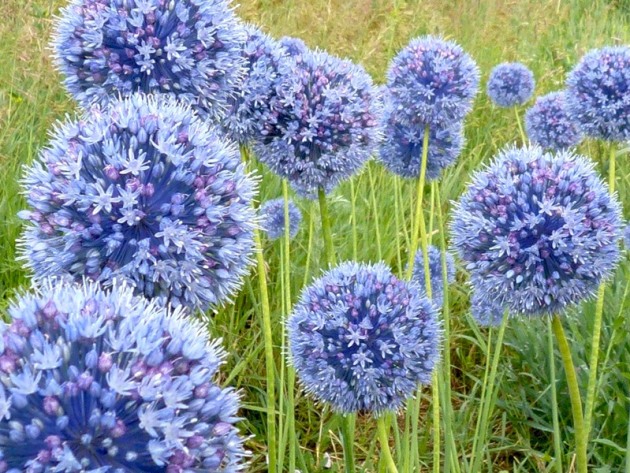


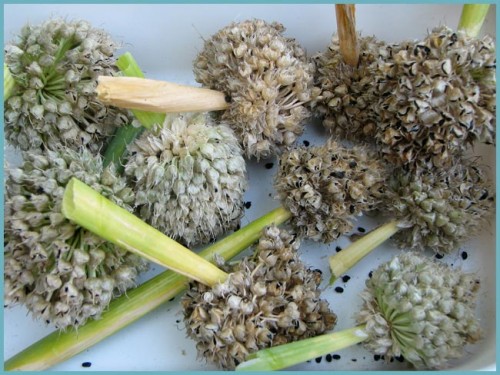

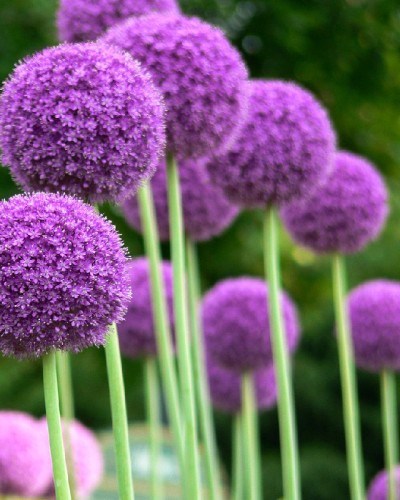
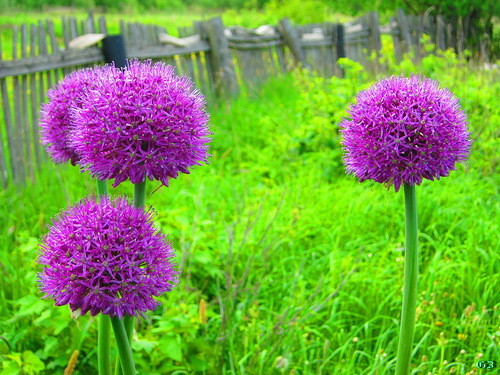
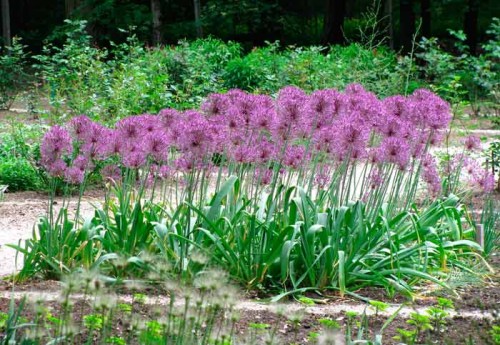

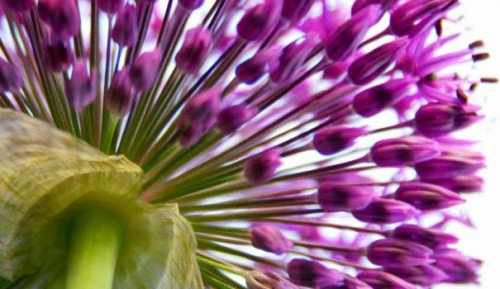
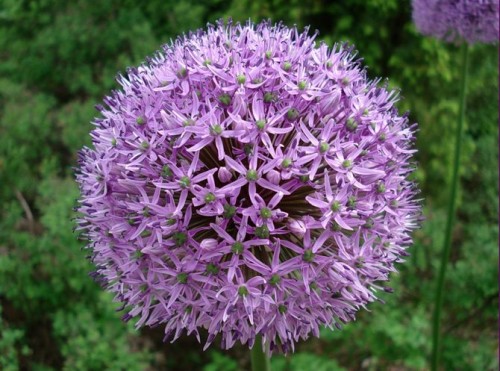
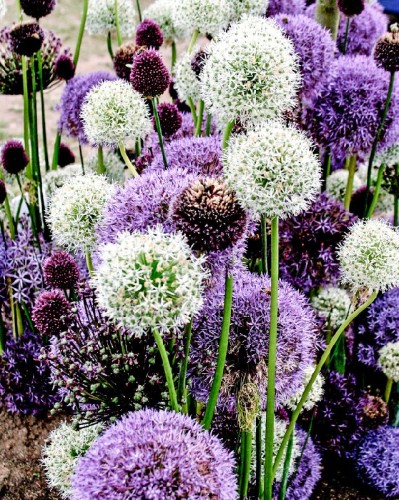
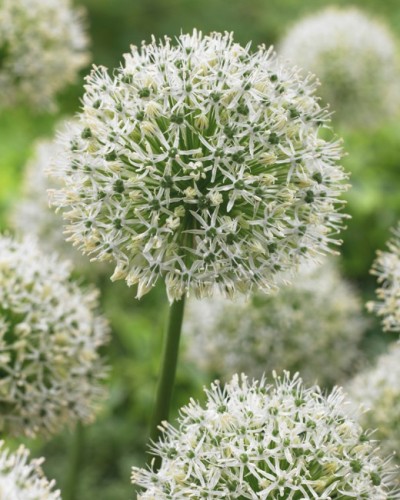












 Start a discussion ...
Start a discussion ...